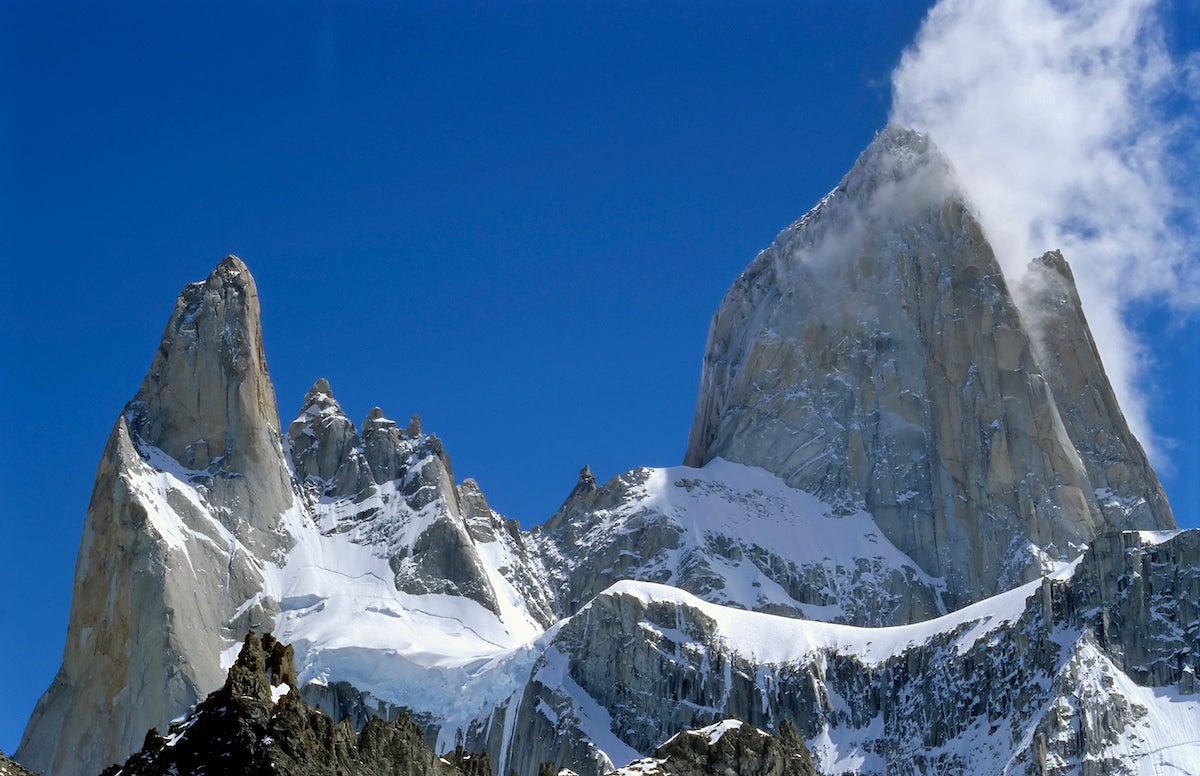10 Things You Didn't Know About Granite

(Photo: elxeneize / Getty)
1.
The word granite comes from the Latin granum, meaning grain. Granite’s distinctive, granular texture is formed by interlocking crystals that develop as molten rock slowly cools underneath the surface of the Earth, solidifying as individual minerals of quartz and feldspar, along with mica and small amounts of other minerals. The size of the crystals depends on the time it takes for the rock to cool. Slow cooling creates coarse, tape-glove-mandatory granite like that found in Vedauwoo, Wyoming, and Joshua Tree, California.
2.
The color of granite mostly depends on the type of feldspar it contains. Granite’s plagioclase feldspars are typically milky white. Alkali feldspars have a range of colors—brick red to emerald green to pale yellow—depending on impurities and trace elements. Pink granites owe their color to red or pink alkali feldspars. Gray or white granites may have white-colored alkali feldspar mixed with the white plagioclase, or they may have little or no alkali feldspar at all, in which case they are technically called granodiorites or tonalites.

3.
Granite forms the world’s tallest cliffs, including the northwest face of Great Trango Tower in Pakistan, probably the tallest with a 5,500-foot cliff drop. Trango is made up of the Baltoro Granite, which also makes up the Latok group of mountains, including the Ogre, Masherbrum, and K7. Nearly as tall are some of the walls in the eastern fjords of Baffin Island, including Polar Sun Spire (4,700-5,000 foot cliff drop). Other large granitic walls and peaks include those of the Mont Blanc massif, Alaska’s Ruth Gorge, the Bugaboos of Canada, and the Fitzroy and Paine groups in Patagonia.
4.
The granites at City of Rocks, Idaho, Cochise Stronghold, Arizona, Mount Lemmon, Arizona, and Little Cottonwood Canyon, Utah, while distinctive, all formed at about the same time, about 30 million years ago, during an episode geologists call a magmatic flare-up. During this time, an oceanic plate that had been sliding underneath North America broke apart, exposing the bottom of the North American continental plate to hot mantle rocks. This heating created new pockets of magma, and eventually bodies of granite—called plutons—cross the American West.
5.
All granite exposed on the surface of the Earth had to be uplifted from depth, usually from about one to 20 miles down. If similar granitic magma cools at the surface, as part of a lava flow or volcanic eruption, it forms rhyolite or rhyolitic tuff. Examples include most of the crags at Penitente Canyon, Colorado, Owens River Gorge, California, and Smith Rocks, Oregon.
6.
Pegmatite is the most notorious choss in Colorado’s Black Canyon, yet pegmatites have a composition similar to granite. Pegmatites are defined by their extremely large crystals anywhere between an inch or two across, to over 20 feet. They grow rapidly out of the last bit of magma in a granite system, magma that is saturated with water and often has an unusual concentration of elements that weren’t compatible with the rest of the crystallized granite. So when that hold breaks off in your hand, check it out before you throw it away: because of these elements, pegmatites are often home to rare gems and minerals like aquamarine, emerald, and tourmaline.
7.
The highest granite mountain in the world is Kangchenjunga (8,586 meters), the world’s third-highest peak, behind Everest (8,848 meters) and K2 (8,611 meters). Kangchenjunga, along with neighboring peaks Makalu and Jannu, is built from a 2.5-mile-thick sheet of light-colored granite that formed from melted rocks deep in the thickened crust of the Himalaya. The summit of Everest, on the other hand, is made up of limestone. The flanks of K2 are carved out of gneiss.
8.
The granite of El Capitan is different from the granite of Half Dome. The El Capitan granite is 102 million years old, and was intruded by diorite, a dark-colored igneous rock that forms part of the North America feature on the southeast face. Half Dome is made of a younger granodiorite (meaning it contains a higher percentage of plagioclase feldspar than true granite) that formed 87 million years ago. Both the El Capitan granite and the Half Dome granodiorite are part of the Sierra Nevada Batholith, an enormous expanse of igneous rocks that formed in the bowels of a chain of volcanoes—similar to the modern-day Andes—that existed up and down the western coast of California about 100 million years ago.
9.
The density of granite is about 162 pounds per cubic foot, about two-and-a-half times heavier than the same volume of water. Granite is the main component of continental crust. Basalt, the main component of oceanic crust, is much denser, about 187 pounds per cubic foot. Sandstone densities are variable, but typically about 137 pounds per cubic foot. By weight, granite is approximately 50 percent oxygen.
10.
Granite is radioactive. Like many other natural materials, it contains trace amounts of uranium. Some granite bodies, however, can have five to 20 times the normal amount of uranium, the byproduct of which is radon gas, which has been shown to cause lung cancer. But don’t worry about significant exposure to radiation from cragging in Yosemite or upgrading your kitchen with lavish stone counters. The biggest concern lies in poorly ventilated basements that are surrounded by soils coming from granite bedrock.